Repair Video File Dropped Frames: Here's How with Tips!
You're watching a video, and suddenly it shuts off or skips! This frustrating scenario is often caused by dropped frames, which can ruin your content and compromise your viewing experience. Can you repair dropped video file frames? Fortunately, yes! Since dropped frames are a common issue, there are several easy and effective ways to fix dropped frames in video files. Learn everything in the following and get your video playing flawlessly again!
Guide List
What Is Dropped Frames and How to Identify 4 Ways to Fix Video File Dropped Frames Tips to Prevent Missing and Bad Video FramesWhat Is Dropped Frames and How to Identify
Dropped frames happen when one or more video frames are skipped during playback or recording. This can make the footage look broken and unwatchable, a common situation that occurs in gameplay recordings, live streams, and corrupted video files. You can clearly identify it by watching sudden jumps, stutters, or constant pauses in the video while the audio continues to play.
And why does this frustrating issue happen? Here are some of the common causes of dropped frames in video:
- Damaged video files due to crashes or errors during transfer.
- Unsupported or mismatched codecs.
- Variable frame rate recordings that interfere with the playback.
- Not enough system resources during the playback.
- Outdated or unstable media players are used.
4 Ways to Fix Video File Dropped Frames
Dropped frames in a video file can significantly ruin your viewing experience, resulting in footage that is choppy, jittery, or completely unplayable. This issue stems from many reasons, like corruption, mismatched codecs, conversion errors, or unstable recordings. Fortunately, several methods are available to remove bad frames and repair dropped video file frames.
Below is a quick summary of the four best fixes, followed by instructions on how each one works:
| Method | Effectiveness | Ideal For |
| AnyRec Video Repair | 5/5 | Severe video frame drops and corrupted video files |
| Change Video Codec | 3/5 | Mismatched codecs and playback errors |
| Update the Media Player | 4/5 | Software-related dropped frame |
| Re-encode Using Handbrake | 2/5 | Encoding issues |
Way 1. Repair Video with AnyRec Video Repair
The first way to repair dropped video file frames is offered by a dedicated video restoration tool called AnyRec Video Repair. This tool is designed to fix corrupted or unplayable video that struggles from dropped frames, skipping, or freezing. Suppose you think that your video file is damaged due to interrupted transfers, recording issues, or file corruption. In that case, this repair software detects the damage in the structure and restores it to its original, smooth playback without compromising quality. Additionally, it supports a wide range of formats, including MP4, MOV, AVI, and others.
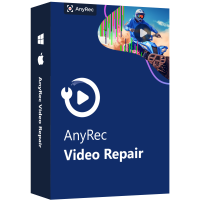
Repair dropped frame, skipping videos, choppy, and more effectively.
Use a healthy sample video to restore the video structure accurately.
Advanced recovery algorithms for deep repair with high quality.
Preview the fixed video to ensure that quality and accuracy have been met.
Secure Download
Secure Download
Step 1.Start by opening AnyRec Video Repair on your computer. Click the "Add" button on the right side to add the dropped video file frames. Alongside it, upload the smooth video sample under a similar size, format, resolution, or device.
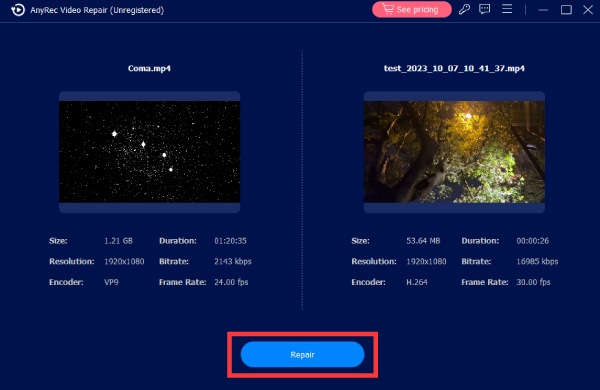
Step 2.After both videos are loaded, click the "Repair" button. The tool will analyze and restore the damaged file, targeting the dropped frames. Once the repair is complete, use the "Preview" button to verify that the video plays smoothly.

Step 3.If the playback is stable now, review the video properties below. Finally, click the "Save" button to export your fully repaired video file to your device. You can even fix laggy OBS recordings.
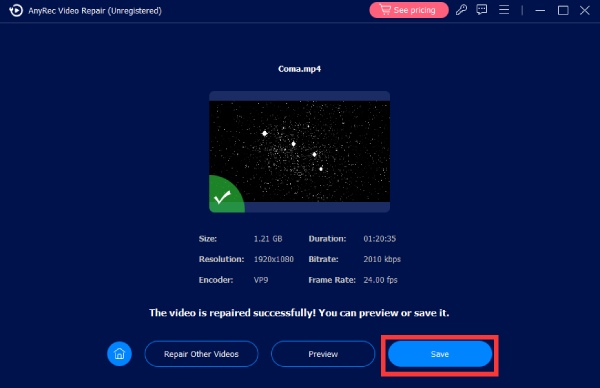
Way 2. Change Video Codec
Sometimes the dropped video file frames occur because the video file has a codec that your device or player cannot decode or does not support. Thus, converting the file to a widely supported one like H.264 will improve the playback. This method is beneficial if you suspect compatibility issues, and it can be done with VLC.
Step 1.Launch VLC, then click on "Media" and select "Convert/Save". Under the "File" tab, click the "Add" button to upload the damaged video file. Click the "Convert/Save" button to proceed.
Step 2.From the "Profile" section, choose a format with the "H.264" codec, such as "Video - H.264 + MP3 (MP4)" to convert VLC to MP4. You can further customize the settings by clicking the "Custom Profile" button next to it. Click the "Start" button now to begin processing.
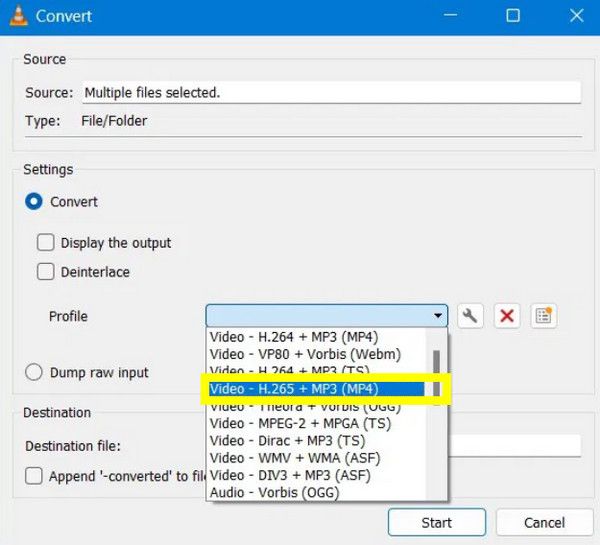
Way 3. Update the Media Player
In some scenarios, the issue lies with the media player being used to play the video. To repair dropped video file frames, you can switch to a modern and more stable player, such as VLC Media Player, or update it, as outdated media players may struggle to handle the specific formats or codecs of your video file.
Step 1.To update a player like VLC, in its top menu, go to "Help" then select "Check for Updates". If a new version is up, a dialog box will appear. Click the "Yes" button to begin.
Step 2.After it is done, run the installer and complete the on-screen instructions. Restart the VLC Media Player.
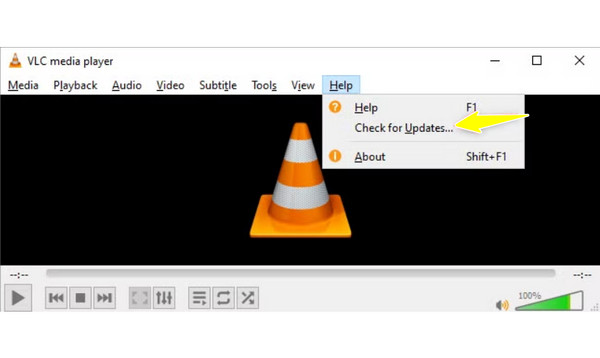
Way 4. Re-encode Using Handbrake
Perhaps the video is recorded with a variable frame rate or experiences improper compression. For this, re-encoding it with fixed settings can help repair dropped video file frames. In this task, Handbrake is a reliable tool that allows you to set a constant frame rate, reprocess the file, and optimize it for smooth playback.
Step 1.After Handbrake is launched, click "File" to add your damaged video file. From the "Summary" tab, select "MP4" as your target format.
Step 2.Next, go to the "Video" tab and set the frame rate to "Constant Frame Rate". Then, put the "Constant Quality" value between 18 and 22. Later, select the file location, then click the "Start Encode" button to repair videos with skipping frames.
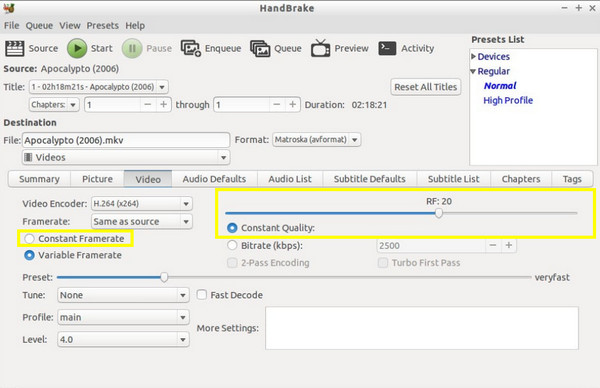
Tips to Prevent Missing and Bad Video Frames
To prevent dropped or bad frames on videos, take proactive steps during recording and video playback. Whether it's for capturing gameplay, editing, or simply watching HD videos, ensuring a stable setup and settings can go a long way in maintaining excellent video quality. Check out the practical tips below to avoid missing and bad video frames:
- 1. Have a Stable Recording Setup. Avoid multitasking or running heavy applications during recording, and ensure that the recording is done on a system with sufficient resources.
- 2. Choose the Right Codec and Format. Choose widely supported codecs, such as H.264, to avoid compatibility issues.
- 3. Set a Constant Frame Rate. Always select a constant frame rate instead of a variable one when using screen recorders.
- 4. Keep Software and Drivers Updated. Update graphic drivers, video editors, media players, and operating systems.
- 5. Monitor System Performance. Check your CPU/GPU usage regularly to avoid overheating or slowdown that results in dropped frames in video files.
- 6. Close Background Apps. During the video capture or export process, free up system resources by exiting from unnecessary apps running.
Conclusion
With the right tools and techniques mentioned, you can repair dropped video file frames and bring them back to life. Whether you're re-encoding with Handbrake, changing codecs, or updating your media player, each fix is tailored to different causes of frame loss. For the best results, especially if your file is damaged or corrupted, AnyRec Video Repair stands out! With its advanced technology being applied and friendliness, it repairs missing video frames and restores video integrity in no time.
Secure Download
Secure Download



